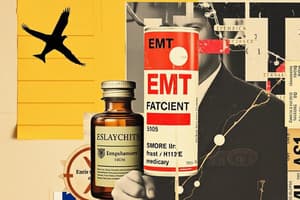Podcast
Questions and Answers
Epinephrine is commonly used to treat severe allergic reactions, also known as ______
Epinephrine is commonly used to treat severe allergic reactions, also known as ______
anaphylaxis
Nitroglycerin is typically used for rapid relief from ______ pain
Nitroglycerin is typically used for rapid relief from ______ pain
chest
Aspirin acts as an antiplatelet drug, preventing platelets from forming ______
Aspirin acts as an antiplatelet drug, preventing platelets from forming ______
clots
Albuterol is a bronchodilator commonly used to treat ______
Albuterol is a bronchodilator commonly used to treat ______
Glucose is used to treat hypoglycemia, a condition characterized by low levels of ______ in the blood
Glucose is used to treat hypoglycemia, a condition characterized by low levels of ______ in the blood
Study Notes
EMT Pharmacology: A Comprehensive Guide to Emergency Medications
As an emergency medical technician (EMT), your role is critical during life-threatening situations. In these scenarios, knowledge of various medications is essential to ensure effective patient care. This guide provides an overview of key medications used by EMTs, including epinephrine, nitroglycerin, aspirin, albuterol, and glucose.
Epinephrine
What It Is
Epinephrine, also known as adrenaline, is a hormone that prepares the body for a fight or flight response. It constricts blood vessels, leading to increased blood pressure and heart rate which can help patients maintain their blood pressure in times of shock.
How It's Administered
Epinephrine is typically injected via an auto-injector to deliver an intramuscular injection into the outer thigh muscles. Automated external defibrillators (AED) often come with epinephrine syringes that can be administered through the defibrillator itself.
When It's Used
Epinephrine is primarily used when there is a need to increase blood pressure due to severe bleeding, hypotension, or cardiac arrest. However, its potential misuse has led to guidelines restricting its administration.
Nitroglycerin
What It Is
Nitroglycerin is a medication used to treat angina pectoris, chest pain caused by reduced blood flow to the heart muscle. It works by dilating coronary arteries to improve blood flow to the heart.
How It's Administered
Nitroglycerin is either sprayed under the tongue or absorbed through the skin using a patch. The spray method delivers the medication rapidly while the patch allows for slower absorption over time.
When It's Used
Nitroglycerin is typically used in situations where rapid relief from chest pain is needed.
Aspirin
What It Is
Aspirin acts as an antiplatelet drug, preventing platelets from sticking together to form clots. This makes it useful for conditions like acute myocardial infarction, stroke, unstable angina, and deep vein thrombosis.
How It's Administered
Aspirin is available in both oral and topical forms, depending on the condition being treated. Oral dosages may range from 100 mg to 900 mg daily, while topical applications vary based on the specific product.
When It's Used
Aspirin is often prescribed to prevent recurrent blood clots related to previous blood clot formation. Some studies suggest that enteric-coated aspirin might be more effective than standard aspirin in treating nonsteroidal antiinflammatory drug-induced ulcers.
Albuterol
What It Is
Albuterol is a bronchodilator commonly used to treat asthma and chronic obstructive pulmonary disease (COPD). By relaxing the smooth muscle in airway walls, it improves airflow within the lungs.
How It's Administered
Albuterol is usually delivered via metered-dose inhalers or nebulization devices. These methods allow for inhalation of the medication directly into the lungs, avoiding the gastrointestinal tract.
When It's Used
Albuterol is primarily used to treat bronchospasms, symptoms of asthma, COPD, or other obstructive airway diseases.
Glucose
What It Is
Glucose, also known as dextrose, is a simple sugar that serves as an essential energy source for living organisms. In the context of EMT care, glucose is used to treat hypoglycemia, a condition characterized by insufficient glucose levels in the blood.
How It's Administered
Glucose can be administered via intravenous (IV) drip, oral ingestion, or glucose gel or glucose tablets. The choice of administration method depends on the severity of the hypoglycemia and the patient's condition.
When It's Used
Glucose is typically administered when the patient is at risk of developing hypoglycemia, such as those with diabetes or those who have prolonged periods without eating.
In conclusion, EMT pharmacology is a vast field that requires a deep understanding of various medications and their uses in emergency situations. By familiarizing yourself with these medications, you can provide better care and potentially save lives. Always ensure proper training and adherence to guidelines when administering medications to ensure optimal patient outcomes.
Studying That Suits You
Use AI to generate personalized quizzes and flashcards to suit your learning preferences.
Description
Explore key emergency medications used by Emergency Medical Technicians (EMTs) including epinephrine, nitroglycerin, aspirin, albuterol, and glucose. Understand their uses, administration methods, and when they are typically prescribed to patients in critical situations.




